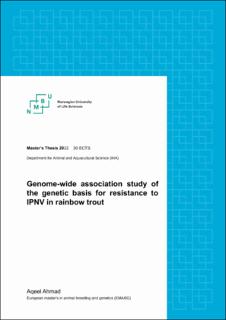| dc.description.abstract | Infectious Pancreatic Necrosis (IPN), caused by the IPN virus, is one of the major threats to the Norwegian rainbow trout (NRT) industry. Despite disinfection, effective management, traditional breeding programs, and efforts to vaccinate the fish, the NRT industry is still prone to IPNV infections, leading to higher mortalities and severe clinical infections in production and breeding stocks, especially at the early life stages. The distinct genetic variations among IPNV isolates and different genetic basis of salmonoids can lead to 10-100% mortalities. The economic losses and welfare concerns called for scientific studies to analyze the molecular pathogenesis and discover the possible solutions to restrict the outbreaks of IPN in aquaculture, which led to the advent of selective breeding as the major step forward. In the present study we have investigated the comparative survival of NRT fry against IPNV challenge and possibilities of reducing this disease problem through selective breeding, and to what extent selection for increased resistance to one pathogenic strain of IPNV will also result in increased resistance to another isolate. It was found that an isolate from Atlantic salmon (IPNV-AS) is more virulent compared to an isolate from rainbow trout (IPNV-RT) which could be attributed to the marked difference in the genetic architecture of the viral genome encoding parts of the viral protein important for host cell interactions and immunogenicity. The estimated heritabilities for survival to both isolates in separate challenge tests were moderate and indicative of potential use in the genomic selection for increased resistance to IPNV in NRT selective breeding programs. The genetic correlation between survival to IPNV-AS and IPNV-RT was very high, meaning that the selection for one of the studied isolates will impart resistance against the other isolate. The GWAS have shown the polygenic nature of the traits under investigation as many QTLs were significantly associated with the traits. This implies that genomic selection is the best way to select against IPNV as it will account for all the genetic variation contributions by the many small QTLs. A detailed understanding of the genetic variation and interactions of the host and the IPNV are crucial in understanding the faith of the disease. Moderate heritability was also found for the viral load to IPNV-AS, and with a moderate negative and thus favorable genetic correlation to survival to IPNV-AS implying that viral load may potentially be used as the preferred selection trait for IPNV as it does not include non-specific mortalities, is more informative than the binary survival trait, and helps to detect clinical infections and carriers in the population. The QTLs should be validated using viral load as a trait, and actual causative mutation should be detected using large-scale data sets. | en_US |

